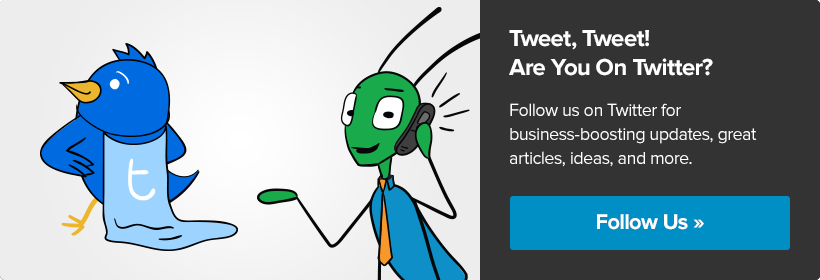When you’re a small business, investing a lot of time and effort into social media can be frustrating.
Even if you’re somewhat Twitter-savvy, there’s no guarantee that your Twitter account is going to spread like wildfire right away. And those web-exclusive promotions you’ve been offering won’t generate a lot of buzz if you only have 35 followers, many of whom are only half-interested in your Tweets to begin with.
The quickest and most direct route to more followers, more clicks to your website, and more Twitter success is simple: sponsored Twitter ads.
We know what you’re thinking. A word like “sponsored” only translates to one thing: spending money.
That’s true. Luckily, despite Twitter’s 400+ million daily tweet popularity, the social media platform is surprisingly small business friendly.
But only if you know what you’re doing.
A Quick Brief on Twitter and Getting Started with Advertising
You’re Internet savvy—after all, you’re reading this, aren’t you?—but we wanted to take just a moment to brush up on the Twitter glossary you’ll need to be familiar with before getting started:
If you’ve spent more than a few minutes on Twitter, you know there’s more to your small business’ presence than mere tweets and favorites. There’s an entire profile to design! There are trends to stay on top of, hashtags to follow, and much more. If any of this gets overwhelming, simply refer to Twitter’s own Twitter 101 section for guidance.
If you already know all this, you’re ready to learn about Twitter advertising.
You can get familiar with the process at Twitter’s Start Advertising section, which asks for a few basic inputs such as business location, your monthly marketing budget, etc. It will then prompt you to sign up.
Don’t worry, there’s no monetary commitment yet. In fact, we don’t want you to get started buying ads until you’ve learned the ins and outs of sponsored Twitter first.
Twitter Sponsored Ads 101
Understanding how sponsored ads work on Twitter requires a basic knowledge of the different kinds of ads you can run:
Knowing the options at your disposal, you can then decide what kind of campaign you want to run. If you simply want more Twitter followers, a Promoted Account is definitely the way to go. If you want to get more people clicking through to your website, a Promoted Tweet will be more effective.
Another essential concept to learn: bids.
You may have heard of bids if you’ve ever run a sponsored Search campaign on Google. Essentially, the higher your “bid” is, the more likely it is that your advertisement will appear to the Twitter users you’re targeting. You’ll set a maximum amount you’re willing to bid, thus ensuring that you set a “cap” on your overall spending.
Fortunately for small businesses, there are ways to manage bids and budgets to ensure you’re seen by plenty of people without a corporate bankroll.
How to Come Up With (Reasonable) Goals for Your Ads
Now that you know the methods of advertising available at Twitter, it’s time to come up with goals that make sense for your small business needs.
First, you have to know what you’re on Twitter for in the first place. Do you want more people to order your product at your website? Do you want more followers so your social media promotions generate more buzz?
When you dig into it, you find out there are a zillion ways to measure Twitter success: a certain amount of re-tweets, twitter replies, favorites, clicks on your promoted tweets, etc.
Coming up with a reasonable goal starts with knowing what you want to get out of your Twitter efforts. Don’t come up with a goal based on what you think Twitter is for, but rather on what will have the most impact on your business.
Using this information, you can then set about creating a goal for your ad campaign. The most important thing: be specific. Knowing exactly how many followers you want, or how many clicks you want to your website, will help you craft a detailed strategy with real, actionable data.
Spending and Budget: What to Expect
Okay, now that you have your goal, it’s time to talk about money.
Twitter recommends starting off your advertising campaign with an average of approximately $1-2. Others, such as SearchEngineWatch.com, have recommended $1.50 to $2.20 for a cost-per-follower campaign.
As a small business, it may be hard to run a campaign long enough with higher bids, so instead start lower and gradually raise it to find out a price that will work for you.
You’ll get the most bang for your buck if you keep a keen eye on the performance of your ad campaign. Twitter helps out by offering analytics that let you review the success—or lack thereof—you’ve experienced with your sponsored ads.
This is of the most powerful tools for small business because you need to squeeze every ounce of juice you can out of your campaigns. Give your sponsored ad campaign time to flesh out with accurate data. You’ll need a large enough sample size to judge whether it’s working or not. But after a while, it’s important to go in, compare your results to your goals, and make adjustments accordingly.
How to Succeed on Twitter
Spirit of 77, a bar in Portland Oregon, is a small business that discovered some noteworthy Twitter success by knowing exactly what kind of customers they wanted to attract.
For starters, Spirit of 77 is a bar, right? So they should go after customers who like to drink. The problem is, that’s too vague—and it does nothing to differentiate the bar from the plethora of competition in Portland.
So Spirit of 77 instead targeted keywords that included relevant conferences, not to mention the hot sporting events of the day (for example, the recent World Cup). Rather than carpet-bomb the entire Portland market with vague advertisements on drink deals, Spirit of 77 found Twitter success by getting specific and seeing things from the customer’s perspective.
@Spiritof77 found more success by targeting users who were tweeting about World Cup games than they would have found targeting users who used the word “drink” online. That’s the kind of specific targeting you should attempt to emulate in your own efforts on Twitter.
Your Turn: What are you wondering about ads on Twitter? Have you tried them? What were your results?


